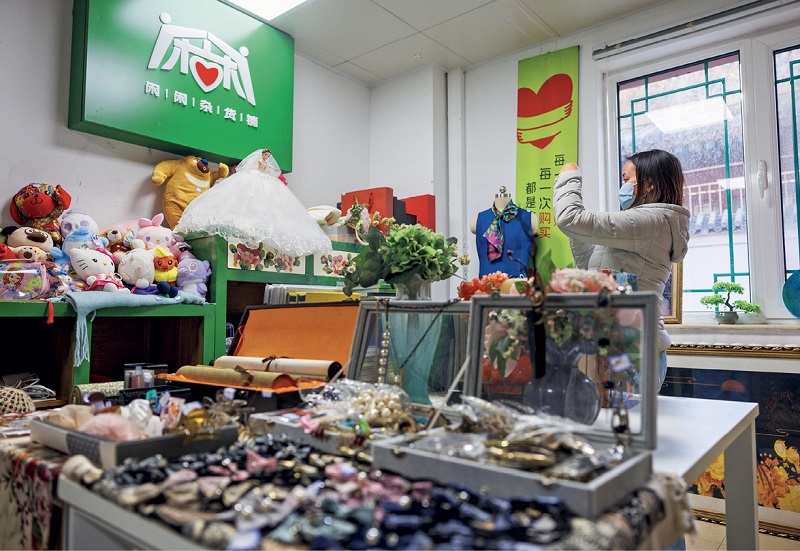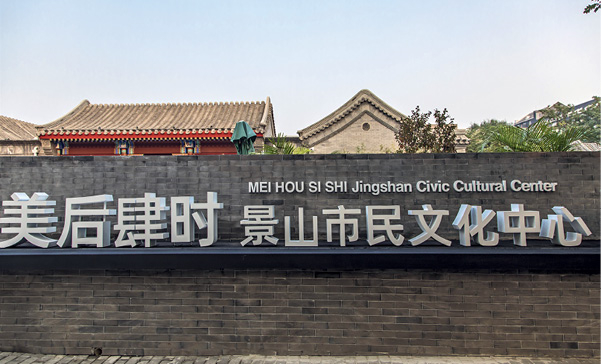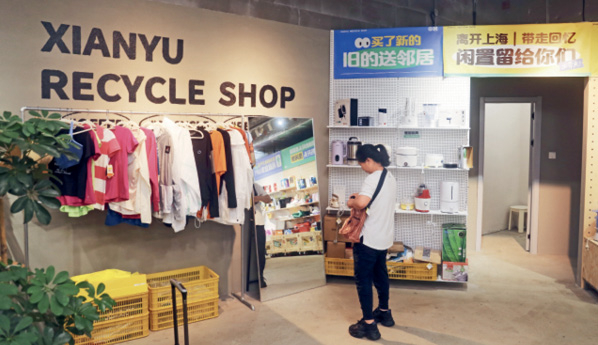The rise of secondhand goods stores, both offline and online, is another way to recycle and reuse, boosting an environment-friendly lifestyle.

A bargain hunter selects products at the Xianxian Secondhand Store, November 6, 2024.
Near the Forbidden City in downtown Beijing, an old subway construction site was turned into a traditional quadrangle courtyard five years ago, becoming a cultural center for local residents to watch movies, attend band performances and go to yoga classes.
The Mei Hou Si Shi Jingshan Civic Cultural Center, as it’s called, has since become one of the largest local cultural venues in Beijing’s old urban area. The name means time is transient but beauty is eternal.
The Xianxian Secondhand Store was opened here in April, adding to the galleries and art studios. “We believe that sustainable fashion is a way of life. So the store offers a platform for people to buy and sell secondhand goods like clothing, digital gadgets, books and toys at bargain prices. All revenue is donated to charitable funds to help community governance,” Li Yachen, operating manager of the cultural center, said.

The Mei Hou Si Shi Jingshan Civic Cultural Center in downtown Beijing, October 9, 2020.
Second Life for Unwanted Items
As you step into the store, you get warm vibes. The poster hanging above the narrow entrance says, “Every donation and every purchase here is for public welfare.” Although not large, the store has a variety of goods, from daily necessities to exquisite handicrafts. With careful selection, everyone is able to find unexpected treasures. “Home goods take up most of our stock,” Li said. “Items such as decorative paintings, lamps and toys in good condition draw customers.”
The items are mostly donated by individuals living nearby as well as businesses. “We accept goods that meet donation standards,” Li said. “They are registered, cleaned and disinfected before our volunteers shelve them.”
The store is run by enthusiastic volunteers who take turns to be the manager for a day. To be a volunteer, all you need is to be “kind and patient and above 10 years.”
Xie Yi, a 34-year-old white-collar worker, is a frequent donor who lives nearby. She used to be a shopaholic, but after deciding to live a minimalist way of life, she threw away or donated most of her stuff. “Baby toys, clothes I no longer wear, a stack of dusty books … this clutter was stressing me at home. But instead of tossing unwanted items into the trash, I can donate them and it makes me feel relieved,” she said.
While the store has raised over RMB 39,000 in donations so far, it also encounters bottlenecks. Many items are often in short supply and the team of the one-day store managers needs to be expanded. “I hope more residents and businesses pay attention to our store and participate,” Li said.
In addition to scattered efforts like the Xianxian Secondhand Store, in Beijing, a more systematic recycling campaign is also underway.
On November 1, 2024, the Beijing branch of China Post launched a green initiative, calling on the public to donate old items. Donors will be given bottles of oyster sauce, drinking water, agricultural produce and other items in exchange according to the weight of items they donate. This service is available at all post offices in the city. People can donate a wide variety of things, from clothing, to shoes, bags, textiles, plush toys and more. Then professional recycling will transform donated items into new resources such as old clothes into recycled fibers and filling materials, contributing to sustainable development.
In recent years, green consumption, sustainable lifestyle and circular economy have become a nationwide trend. Against this backdrop, the secondhand goods industry is also undergoing unprecedented changes and prosperity.
According to the Secondhand Industry Development Report 2024 issued by China Resale Goods Trading Association in September, 76.5 percent of people in China have sold things to second-hand goods dealers. In 2023, second-hand e-commerce users hit 580 million, a year-on-year increase of over 25 percent.

The Xianyu Recycle Shop in Shanghai, August 9, 2024.
Trading Ecosystem for Used Goods
Along with the soaring growth, a trading ecosystem for secondhand items on social platforms such as WeChat, Xiaohongshu and well-known professional apps such as Xianyu and Kongzishu.com has also evolved. Users can post product information on them and communicate directly with potential buyers. This trading mode is especially suitable for small items or items that need to be sold urgently. Besides, transactions on them enable users to share their personal experiences.
Take the Xianyu app as an example, which nabbed the top spot with users giving it an exceptionally high score for both the quality and diversity of goods. In a strict sense, its users are not real sellers or buyers, but ordinary people who sell some of their idle items and also take a browse to see if there’s anything interesting to buy. Most importantly, bargain hunters are safe from Internet scams, as every user on Xianyu is bound to Alipay, which requires real names and ID numbers to get registered.
According to data released by QuestMobile in April 2024, there are 162 million monthly active users on the app, 43 percent of whom were born after 1995. They have a higher acceptance of second-hand goods, especially animation, comics, and games products, and plants.
Here, apart from circulating idle items, users can also find like-minded people, and get understanding and support.
Geng Ben Bu Xing, who used to work in a state-owned enterprise, is a millennial Xianyu user. He was one of the earliest figurine painters on Xianyu. After finding the platform, where his works are appreciated, he resigned from his stable job, a choice his family and friends didn’t quite understand at the beginning. His craftsmanship gradually gained recognition, and he is now able to support himself with his interests. The number of young artisans like him is on the rise on Xianyu, hoping both to develop hobbies and make some extra money.
From traditional secondhand street markets to modern online trading platforms, from specialty stores focusing on one category to comprehensive online malls covering a wide range of products, the format of the secondhand goods industry is becoming increasingly diversified.
Popular online markets, vibrant offline flea markets, various social media platforms, and local lifestyle service platforms are not only meeting the needs of different consumer groups, but also promoting recycling of resources and driving the sustainable development of the industry.